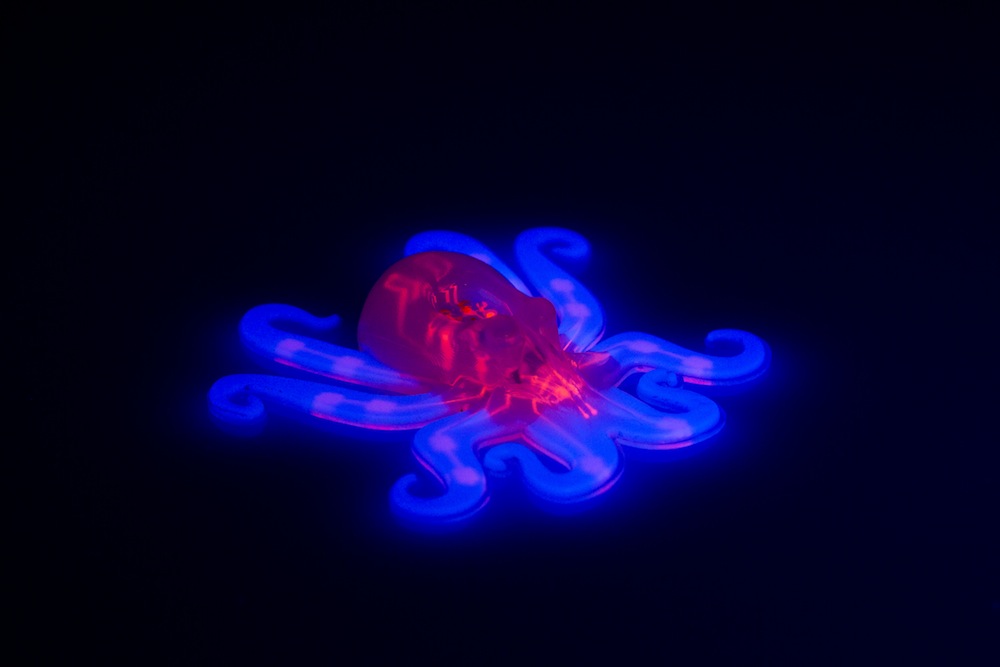Soft, Rubbery 'Octobot' Can Move Without Batteries


A rubbery little "octobot" is the first robot made completely from soft parts, according to a new study. The tiny, squishy guy also doesn't need batteries or wires of any kind, and runs on a liquid fuel.
The octopus-like robot is made of silicone rubber, and measures about 2.5 inches (6.5 centimeters) wide and long. The researchers say soft robots can adapt more easily to some environments than rigid machines, and this research could lead to autonomous robots that can sense their surroundings and interact with people.
Conventional robots are typically made from rigid parts, which makes them vulnerable to harm from bumps, scrapes, twists and falls. These hard parts can also hinder them from being able to squirm past obstacles. Increasingly, scientists are building robots made of soft, elastic plastic and rubber, designs inspired by octopuses, starfish and worms. These soft robots are generally more resistant to damage, and can wriggle past many of the obstacles that impair hard robots. [The 6 Strangest Robots Ever Created]
However, soft robots were previously limited by rigid batteries or wires needed to power the bots. Now, "we are very excited to present a completely soft, untethered robot," said study co-lead author Michael Wehner, a research associate in materials science and mechanical engineering at Harvard University. "As the field of soft robotics continues to rapidly expand, we feel that our work will allow the field to rapidly move forward in a whole new direction."
The octobot has eight arms (hence the name) that are pneumatically driven by steady streams of oxygen gas. This gas is given off by liquid hydrogen peroxide fuel after it chemically reacts with platinum catalysts.
The 0.2-ounce (6 grams) robot is controlled using tiny 3D-printed networks of plumbing. Whereas conventional microelectronic circuits shuffle electrons around wires, scientists in recent years have begun developing microfluidic circuitry that can shuffle fluids around pipes. These devices can theoretically perform any operation a regular electronic microchip can, previous research suggested.
The octobot's microfluidic controller is filled with the liquid hydrogen peroxide fuel. As the fuel gives off oxygen, pressure from the gas builds up in the controller and eventually causes some valves to open and others to close, inflating chambers in half the robot's arms and forcing them to move. Pressurized gas then builds up once more, triggering valve openings and closures that make the other robot's arms move.
Get the world’s most fascinating discoveries delivered straight to your inbox.
So far, the octobot can only wave its arms. The scientists are now working on developing completely soft machines that are more complex and can propel themselves, and perhaps swim, Wehner said. "Integrated sensors would also allow reaction to the bot's environment," Wehner told Live Science. [Photos: Amazing Tech Inspired by the Octopus]
There is no on-off switch for this current version of the octobot — it activates once it gets filled with fuel, Wehner said. Future bots with more complex controllers and sensors could be envisioned with on-off switches, he noted.
The octobot can currently run for about 4 to 8 minutes. The researchers said they can probably improve the bot's run-time using more sophisticated designs that better control how the fuel is used.
"We foresee soft robots expanding the role of robots in human-populated environments — human-robot interaction," Wehner said.
In addition, "a separate but very interesting potential application for this type of robot is in high-risk, dangerous areas such as search and rescue," Wehner said. "The total material cost for the octobot is just over $2, and fuel costs approximately 5 cents per fill. One could envision a scenario in which 100 bots are deployed to investigate a scene, anticipating that 80 would be destroyed."
The scientists detailed their findings online today (Aug. 24) in the journal Nature.
Original article on Live Science.



